Related Research Articles

A cocktail is an alcoholic mixed drink or non alcoholic mixed drink. Most commonly, a cocktail is a combination of one or more spirits mixed with other ingredients, such as juices, flavored syrups, tonic water, shrubs, and bitters. Cocktails vary widely across regions of the world, and many websites publish both original recipes and their own interpretations of older and more famous cocktails.

A Manhattan is a cocktail made with whiskey, sweet vermouth, and bitters. While rye is the traditional whiskey of choice, other commonly used whiskies include Canadian whisky, bourbon, blended whiskey, and Tennessee whiskey. The cocktail is usually stirred with ice then strained into a chilled cocktail glass and garnished traditionally with a maraschino cherry. A Manhattan may also be served on the rocks in a lowball glass.
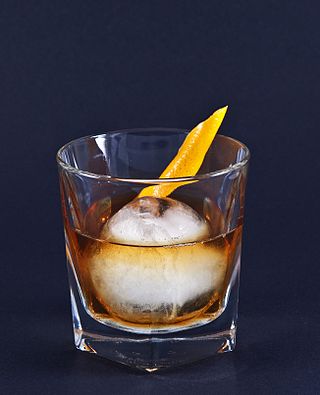
The old fashioned is a cocktail made by muddling sugar with bitters and water, adding whiskey or sometimes brandy, and garnishing with an orange slice or zest and a cocktail cherry. It is traditionally served with ice in an old fashioned glass.

The Sazerac is a local variation of a cognac or whiskey cocktail originally from New Orleans, named for the Sazerac de Forge et Fils brand of cognac brandy that served as its original main ingredient. The drink is most traditionally a combination of cognac or rye whiskey, absinthe, Peychaud's Bitters, and sugar, although bourbon whiskey is sometimes substituted for the rye and Herbsaint is sometimes substituted for the absinthe. Some claim it is the oldest known American cocktail, with origins in antebellum New Orleans, although drink historian David Wondrich is among those who dispute this, and American instances of published usage of the word cocktail to describe a mixture of spirits, bitters, and sugar can be traced to the dawn of the 19th century.

A bitters is traditionally an alcoholic preparation flavored with botanical matter for a bitter or bittersweet flavor. Originally, numerous longstanding brands of bitters were developed as patent medicines, but now are sold as digestifs, sometimes with herbal properties, and as cocktail flavorings.

The martini is a cocktail made with gin and vermouth, and garnished with an olive or a lemon twist. Over the years, the martini has become one of the best-known mixed alcoholic beverages. A variation, the vodka martini, uses vodka instead of gin for the cocktail's base spirit.
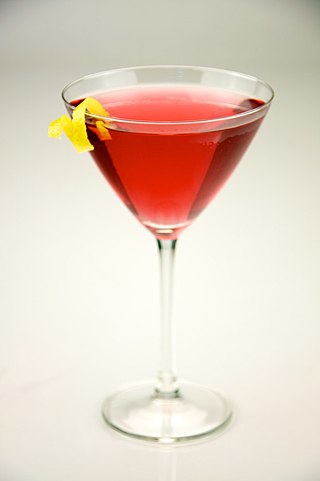
A cosmopolitan, or, informally, a cosmo, is a cocktail made with vodka, Cointreau, cranberry juice, and freshly squeezed or sweetened lime juice.

The negroni is a cocktail, made of equal parts gin, vermouth rosso, and Campari, generally served on the rocks, and commonly garnished with an orange slice or orange peel. It is considered an apéritif.
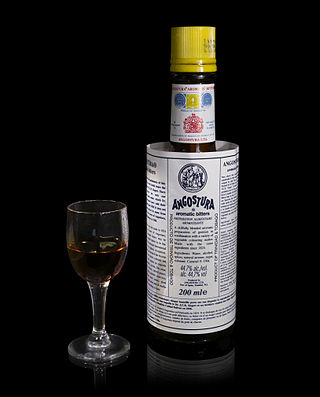
Angostura bitters is a concentrated bitters based on gentian, herbs, and spices, produced by House of Angostura in Trinidad and Tobago. It is typically used for flavouring beverages, or less often, food. The bitters were first produced in the town of Angostura, hence the name, but do not contain angostura bark. The bottle is recognisable by its distinctive oversized label. Angostura is Spanish for "narrowing", the town of Angostura having been at the first narrowing of the Orinoco River.

The Pacific-Union Club is a social club located at 1000 California Street in San Francisco, California, at the top of Nob Hill. It is considered to be the most elite club of the West Coast, and one of the most elite clubs in the United States, along with the Knickerbocker Club in New York, the Metropolitan Club in Washington D.C., and the Somerset Club in Boston.
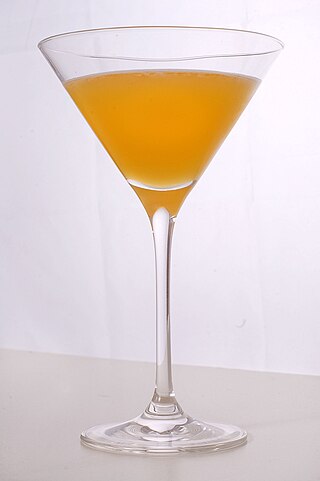
The Bronx is a cocktail. It is essentially a Perfect Martini with orange juice added. It was ranked number three in "The World's 10 Most Famous Cocktails in 1934" behind the Martini (#1) and the Manhattan (#2). In the 1934 movie "The Thin Man", the lead actor compared the methods for shaking the Manhattan, the Bronx and the Martini.

The Fine Art of Mixing Drinks is a book about cocktails by David A. Embury, first published in 1948. The book is noteworthy for its witty, highly opinionated and conversational tone, as well as its categorization of cocktails into two main types: aromatic and sour; its categorization of ingredients into three categories: the base, modifying agents, and special flavorings and coloring agents; and its 1:2:8 ratio for sour type cocktails.
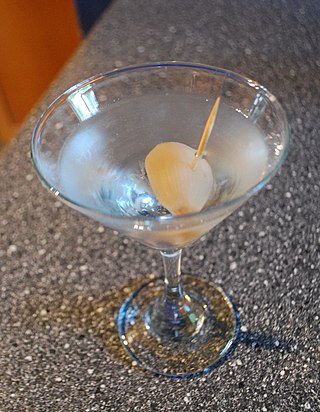
The Gibson is a mixed drink made with gin and dry vermouth, and often garnished with a pickled onion. In its modern incarnation, it is considered a cousin of the ubiquitous martini, distinguished mostly by garnishing with an onion instead of an olive. But the earliest recipes for a Gibson – including the first known recipe published in 1908 by Sir David Austin – are differentiated more by how they treat the addition of bitters.
The Revelation appears in William "Cocktail" Boothby's 1908 work, The World's Drinks And How To Mix Them as "A swell after-dinner drink."
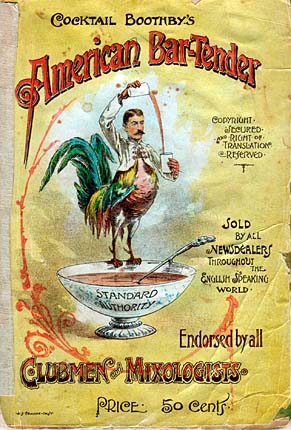
William T. "Cocktail Bill" Boothby was an American bartender and writer of San Francisco, California in the years before and after the 1906 San Francisco earthquake. He tended bar for many years at San Francisco's Palace Hotel. He also served in the California State Assembly for the 43rd district from 1895 to 1897.

The World's Drinks And How To Mix Them is a cocktail manual by William "Cocktail" Boothby originally published in 1900, with revised editions in 1908, 1930 and 1934. The publisher was the Palace Hotel in San Francisco, where Boothby worked.
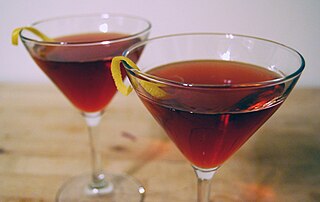
The old pal is a cocktail consisting of equal parts rye whiskey, French vermouth (dry), and Campari.
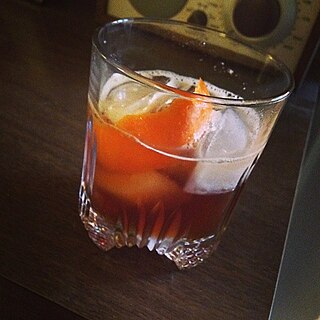
The Toronto is a dry, rich, and mildly bitter cocktail consisting of rye whisky, Fernet-Branca, angostura bitters, and either sugar or simple syrup. An article in Gizmodo by Brent Rose describes it as the "most popular legit cocktail that uses fernet". It is named after the Canadian city of Toronto.
The Blackthorn is an Irish whiskey or sloe gin based cocktail. Both versions emerged in the late 19th and early 20th century.
References
- ↑ Boothby, William "Cocktail". The World's Drinks and How to Mix Them, 1908. Photographed at San Francisco Public Library Historical Materials Collection on December 28, 2007.